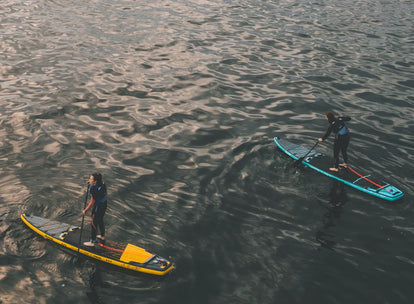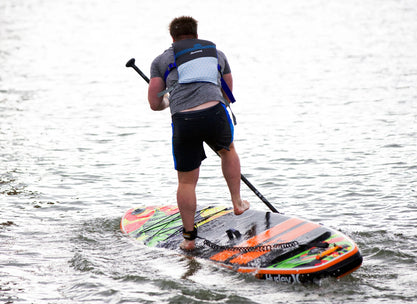Falling off your paddle board is an inevitable part of the journey towards becoming a pro paddle boarder, and most of the time it’s just down to your level of experience. However, if you’ve been paddle boarding for a while, and are still spending more time in the water than you are on the board, then there may be some really easy quick fixes to your technique. These tips can help to improve your performance tenfold and stop you falling off your board so often.
1. Choosing the wrong location or weather conditions

A key influence on how easy or not-easy your paddle boarding session is going to be is heavily dependent on the environment that you are going out into. Choosing to paddle board in locations where the water is calmer is going to make it much easier for you to keep your balance. With that in mind, if you’re struggling to stay on your paddle board then you should look to practice in flat, calm bodies of water like lakes rather than moving seas or flowing rivers. These tend to be more sheltered and therefore are less likely to have waves and other challenges that can cause a fall. Once you get the hang of less challenging conditions you can build up to rougher waters.
2. Not keeping your knees loose

It can be instinct to lock your legs in a fixed position when you first try standing, also once you have a little success staying upright, it’s easy to let your knees lock in an upright position. Both these make you vulnerable to small knocks and wobbles.
You should have a very slight bend in your knees when you paddle and keep your legs loose and limber. Your knees become shock absorbers which help will stop you pivoting too far forwards or backwards at the hips. This helps you adjust your weight distribution when the board is rocked by waves or wind. If your legs are fixed and knees are locked you won't be able to neutralise the movement as easily and will be thrown off balance easier.
3. You’re not paddling enough

When you start to feel some bumpy waves or ripples under your board it can feel natural to lift your paddle out of the water and brace for balance. With paddle boarding however it’s important to remember the golden rule of ‘mobility is stability’. Imagine riding a bike, what happens if you stop pedalling? Eventually you’re going to lose the momentum and topple over. The same idea can be applied to paddle boarding, standing on a stationary board in water is actually much harder to balance than when you're paddling.
Also - keep your paddle near the water and ready to help provide a bracing stroke to help you balance. Not only does this naturally lower your centre of gravity, but the paddle in the water forms a third point in a ‘triangle of stability’ that makes you much more difficult to spill off the board.
4. You aren’t standing in the centre of the paddle board

Another reason that you keep falling off your paddle board is because you are not standing on the board correctly or in the right place. If you’re not standing in the centre of the board, your weight is not going to be evenly distributed and then it won’t take much to throw you off.
The position of the handle is the easiest way to identify the middle of the board, you can then use this as a guide for your feet placement with a foot each side parallel to the handle. Make sure your feet are shoulder width apart and not any wider as this can also cause instability. It’s a good idea to periodically check whilst you’re paddle boarding that you are still in the middle of the board as you can very easily end up moving more than you realise.
As you progress, you will start deliberately moving your feet to different positions to trim and steer the board, but to begin with, keeping in the normal or neutral foot position will help the most.
5. You’re looking at your feet

Now, as important as it is to check that you’re standing in the right position and in the right place on the board, do not spend the whole time staring at your feet, it will not help you balance. Back to our cycling analogy: you wouldn't ride along staring down at the front wheel (for long). Instead, keep your head up facing the direction you are travelling in. Keeping your head and eyes in front will; help you to balance better, allow you to identify potential hazards quicker, and also means you’ll be able to take in the views, which after all is one of the main benefits of going paddle boarding in the first place!
6. Your board isn’t right for you
If you’re following all these tips and still falling in more than you think you should be, it might not be to do with your technique at all, in fact you could have the wrong board for your needs. All paddle boards have maximum weight guidelines, if you’re nearing these weight limits (remember to include the weight of belongings, pets and passengers!) then the board will sit lower in the water and can even sink in the middle, this is going to reduce the stability and make you more likely to fall. For the best performance and stability, choose a board with a weight capacity that puts you in the middle of the range rather than towards the top.
The more narrow and shorter a board is, the more challenging it can be to balance too, especially if you are a tall or heavy paddler. Practice and perseverance will get most paddlers there in time and as you progress, you may appreciate a slicker, more nimble board.
Although falling off your paddle board can be frustrating, it’s important to remember that even the most experienced of paddle boarders will fall off every now and again and it is all part of the process of learning. If you’re getting wetter, you’re getting better!


